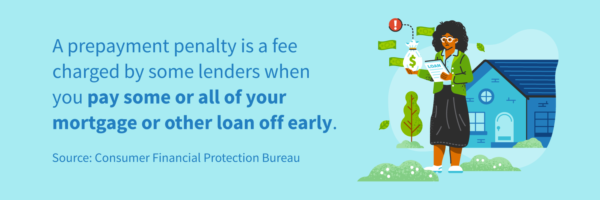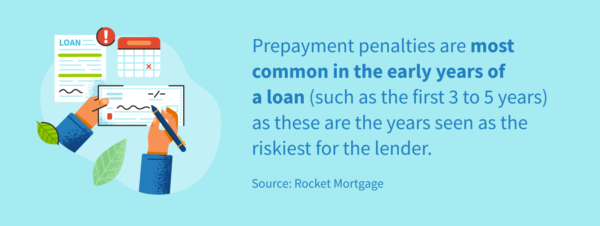
Disclosure regarding our editorial content standards.
A prepayment penalty is a fee charged by some lenders when you pay some or all of your loan (most often mortgages) back early. This may be confusing, causing you to wonder: why would a lender punish someone for paying off a loan early?
As a borrower, it’s important to stay educated on what penalties and terms to look out for when taking out a loan. Read on to learn more about all things related to prepayment penalties, including how they work, what loans you can expect to find them attached to and their potential effect on your credit.
How a prepayment penalty works
A prepayment penalty is usually charged on large loans, most commonly on mortgages. These penalties serve as an incentive to pay your loan back slowly, over the agreed-upon timeframe, so lenders can collect interest on your loan. These penalties are most commonly your responsibility to pay back, not the guarantor, though this may depend on your lender.
Prepayment penalties are usually only enforced if you pay off the entire loan balance—if you sell your home or refinance your mortgage, for example—within a specific number of years, typically three to five. They can also apply if you pay off a large portion of your loan at once, which makes it easier to pay off the loan as a whole faster.
These penalties are usually applied to the first few years of the loan, as these are generally seen as the riskiest for the lender.
Generally, prepayment penalties do not apply if you pay extra principal on your loan in smaller amounts over time. However, it’s always recommended to check with your lender on their payment terms and whether or not they charge prepayment penalties before doing so.

How much are prepayment penalties?
Unfortunately for borrowers, the exact cost of prepayment penalties will vary based on a variety of factors, including your lender, borrowing terms and type of loan. Below are a few standard models for calculating penalty cost, though it should be noted that the exact costs of a prepayment penalty will vary from person to person.
- Fixed amount: Calculated by the lender establishing a set penalty (such as $5,000) to be paid if the loan is paid off within the first year.
- These are not generally used for mortgage prepayment penalties.
- Percentage of remaining balance: The lender assigns a small percentage (such as 3 percent) of the outstanding principal balance as a penalty fee if the loan is paid off within the first two to three years.
- Sliding scale based on mortgage length: The most common model for determining prepayment penalty fees is determined by the remaining years left on the mortgage.
- For example, in a 2/1 penalty established over the first two years of the loan, a 2 percent penalty of the principal balance would be applied if the loan was paid off in the first year. A 1 percent penalty would apply to the remaining balance if paid off in year two.
- A set number of months’ interest: Calculated by paying off a certain number of months’ interest predetermined by the lenders.
Types of prepayment penalties
To ensure you know if and when your prepayment penalty will kick in, it’s important to know the difference between the two types of penalties: hard and soft.
Soft penalty
A soft prepayment penalty allows you, as the mortgage borrower, to sell your home without invoking the penalty. This means the penalty would only apply if you refinanced your loan or paid off a large chunk of the loan in the first few years.
Hard penalty
A hard prepayment penalty has the same terms as a soft penalty, but the penalty also applies if you sell your home. When agreeing to your lease terms, a lender should make you aware of whether you have a soft or hard penalty so you can plan accordingly.
Loans that may have prepayment penalties
As previously mentioned, prepayment penalties are most commonly associated with mortgages. There are a few other types of loans that may have prepayment penalties, though these are often less common.
There are also a few loans where prepayment penalties are illegal. These include:
- FHA loans
- VA loans
- USDA loans
- Personal and student loans
Mortgages
Prepayment penalties have become less common on mortgages since the 2008 housing crisis, though they still exist for some lenders. Most commonly, you’ll come across the terms for a prepayment penalty in your closing documents after buying your home.
Prepayment penalties are most common in mortgages because these are large loans that some lenders see as risky, especially if lending to first-time homeowners. The types of mortgage loans that most commonly have prepayment penalties are conventional loans and subprime mortgages.
Auto loans
Though decidedly less common than a prepayment penalty being attached to a mortgage, some auto loans also have these penalties written into their terms. If this is the case, then much of the same penalty terms will apply to the auto loan as to mortgages—including having a hard or soft penalty and how the penalty is calculated.
Other loans
Even though prepayment penalties have become less common in recent years, there are still other types of loans beyond auto and mortgage loans that can have these terms attached. Below are a few examples of other loan types where you may see prepayment penalties:
- Small business (SBA) loans
- Large non-recourse loans
- Investment property loans
- Loans from alternative lenders

How to avoid prepayment penalties
To avoid prepayment penalties, there are a few routes you can take:
- Ask your lender outright if this is something they charge. If they do, ask them to direct you to where in your loan you can find the details. (If you already have a loan, this information should be available in your monthly billing statements.)
- You’ll want to educate yourself on exactly what triggers the penalty, so you can avoid doing that if possible—for instance, is it a hard or soft prepayment penalty?
- As previously mentioned, prepayment penalties will likely not be enforced if you make a few larger mortgage payments every so often, so if you do have prepayment penalties, consider making a few larger payments sporadically so you won’t be charged a penalty.
Being an educated borrower means being aware of your loan terms and ensuring you know what sort of penalties are attached to your loan. Not only does this give you more control over your finances, but it also helps ensure your credit won’t take a hit when you’re met with an unexpected penalty.
Note: The information provided on CreditRepair.com does not, and is not intended to, act as legal, financial or credit advice; instead, it is for general informational purposes only.
Questions about credit repair?
Chat with an expert: 1-800-255-0263






